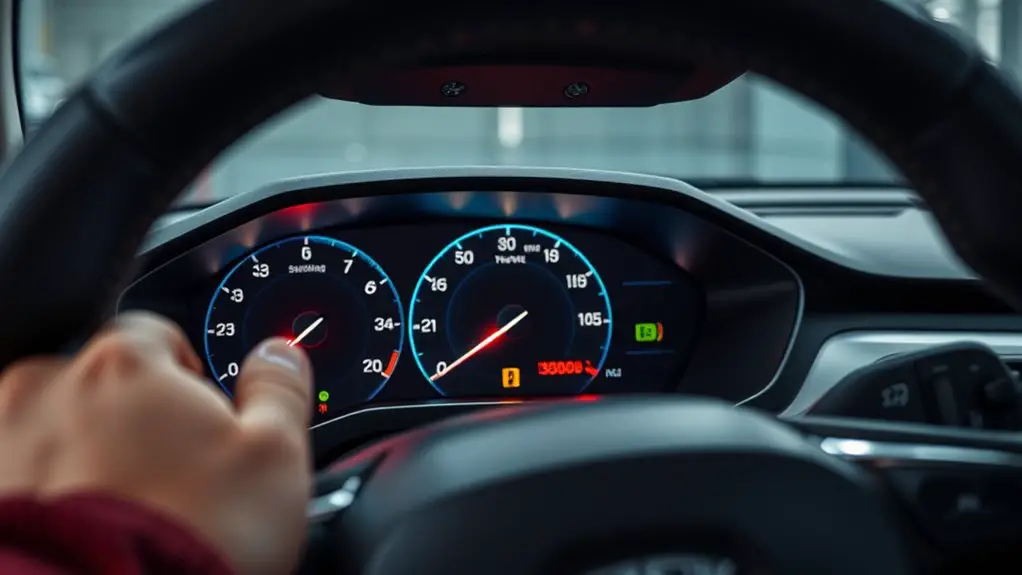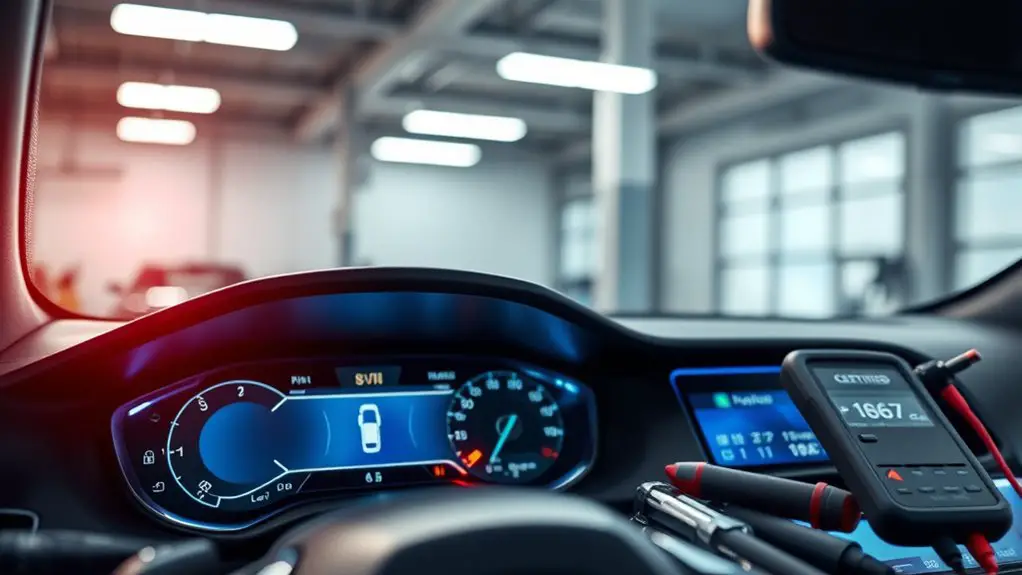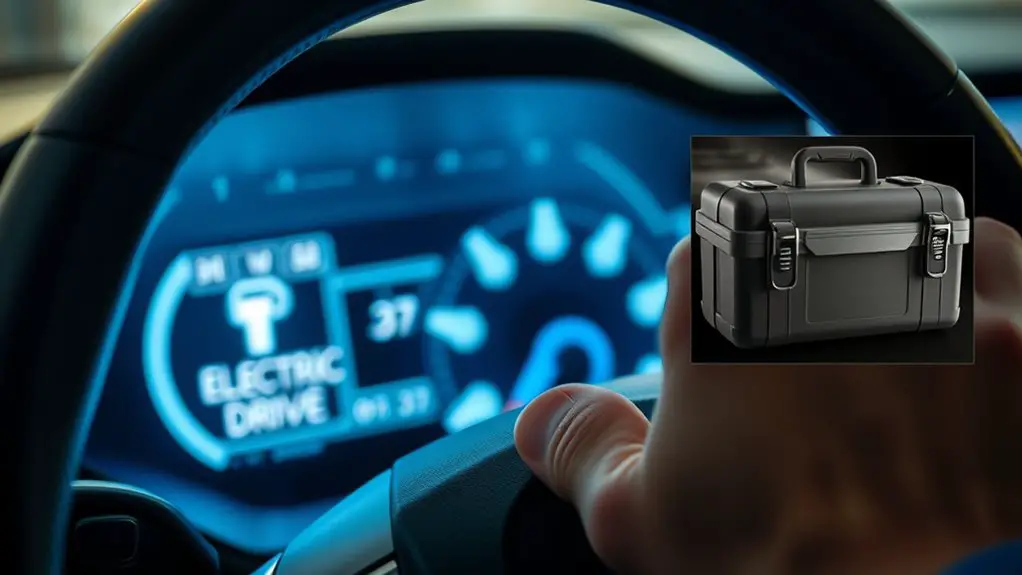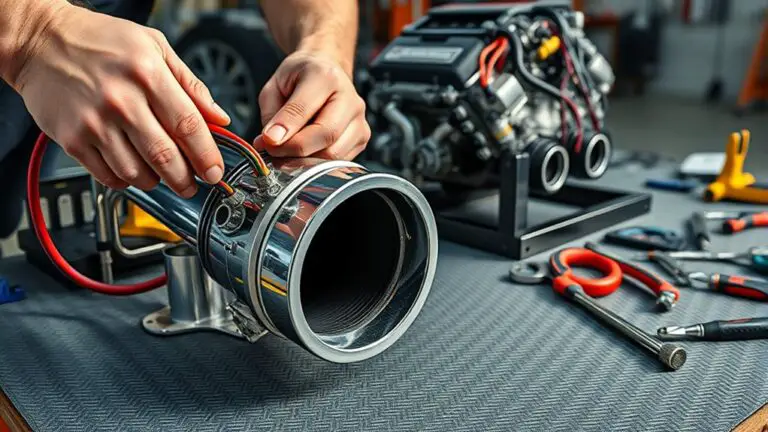Cost and Safety: When to Call Certified EV Technicians for Electric Drive Warning Light
If your EV’s electric drive warning light comes on, pull over safely and assess any immediate symptoms like overheating, loss of power, or strange noises. Don’t DIY diagnose or bypass safety interlocks—high voltage work requires a certified EV technician. They’ll verify fault codes, observe the vehicle at rest, and perform targeted tests, which can save you money and prevent further damage. Early professional help reduces risk and long-term costs, and you’ll learn more about the process ahead.
Understanding the Electric Drive Warning Light: What It Signals

The electric drive warning light signals that there may be an issue with your vehicle’s propulsion system, including the motor, inverter, or drivetrain sensors. When it illuminates, you should assess safety first: pull over if you’re in traffic, and avoid high-speed maneuvers. This light isn’t universal; it can indicate several possibilities, from minor sensor glitches to more serious propulsion faults. You’ll want to understand electric drive functions to interpret the risk and respond calmly. Check for accompanying symptoms—strange noises, reduced acceleration, or unusual vibrations—and note any dashboard codes or fault messages. If the warning light means a transient fault, you might still be able to continue driving cautiously to a safe location, but don’t push your luck. In all cases, plan a thorough diagnostic with a certified technician. Timely attention prevents battery or motor damage and preserves overall safety, performance, and your sense of freedom on the road.
Common Causes of Drive Warning Lights in EVs

Understanding drive warning lights starts with checking battery health signals, since a weakening pack can trigger alerts before performance drops. Inverter fault indicators and improper cooling can also light up warnings, so verify cooling fans and electrical connections first. If these checks don’t clarify the issue, treat the situation as potentially safety-critical and consult a qualified EV technician promptly.
Battery Health Signals
Battery health signals light up for a reason, and spotting the ailing battery early can prevent breakdowns or costly repairs. You’ll notice health indicators like sudden voltage drops, unusual charging rates, or faster-than-usual range loss. A healthy pack shows stable current flow, consistent temperatures, and predictable state of charge behavior. If you see creeping S.O.C. fluctuations or abnormal battery temperatures, treat it as a warning, not a nuisance. Regular battery maintenance—clean connections, verified cooling, and software updates—helps keep the pack within safe limits. Be aware of degraded capacity that reduces your usable range and may trigger warning lights under load. When in doubt, document symptoms and consult professionals; accurate diagnostics protect safety, performance, and your freedom to drive confidently.
Inverter Fault Indicators
When battery health issues show up, it’s natural to assume the problem ends there, but another common source of drive warning lights lies in the inverter. You should know that inverter fault indicators can stem from electrical noise, degraded capacitors, or wiring harness damage, all risking sudden power loss. A blinking or steady warning may point to overcurrent, short circuits, or temperature-related trips inside the inverter module. Regular inverter maintenance helps identify worn connectors, loose grounds, and degraded insulation before a failure occurs. If you notice unexpected power hesitation, abnormal vibration, or unusual sounds, treat it as a precautionary signal. Don’t delay professional inspection; inverter issues demand certified expertise to protect safety, performance, and long-term freedom on the road.
Motor Temperature Alerts
Motor temperature alerts are a crucial safety signal you’ll want to heed. When these alerts fire, you’re seeing potential motor overheating, a sign that thermal management isn’t keeping pace. You should stop if safe, assess cooling airflow, and avoid aggressive throttle until the system stabilizes. Prolonged overheating can degrade magnets, windings, and insulation, increasing repair risk.
| Heat risk | Action |
|---|---|
| Airflow blocked | Clear vents, inspect ducts |
| Coolant issue | Check level, leaks, pump |
| Ambient heat surge | Pause charging, allow cooldown |
Thermal management systems are built to protect efficiency and longevity. If warnings persist after basic checks, don’t delay—call a certified EV technician to diagnose wiring, sensors, and cooling circuits. Your freedom depends on reliable, certified support.
Assessing Risk and Urgency: When to Worry

When you notice a warning vs. severity mismatch, treat it as a signal to prioritize evaluation rather than guesswork. Distinguish between immediate hazards needing urgent service and routine, scheduled checks to prevent risk, and watch for indicators that cross from cautionary to dangerous. If you encounter hazardous indicators—like persistent overheating, strange smells, or loss of power—pull over safely and seek urgent diagnostics.
Warning vs. Severity
Carefully distinguishing warning signs from true severity helps you gauge risk and decide when to call an EV technician. You’ll learn to separate a warning light’s nuisance signals from indicators of real danger. Not every alert means imminent failure, but some point to safety-critical issues. Focus on context: sudden noise, braking changes, or loss of power alongside a warning light signals heightened risk. Compare to mild fluctuations that stabilize after a restart or normal driving. When severity levels escalate—consistent illumination, rapid dimming, or repeated cycles—treat it as urgent. Document symptoms, note when they occur, and avoid aggressive driving toward home. If in doubt, err on the side of caution and consult a certified technician. Prioritizing safety protects you and your investment.
Immediate Vs Scheduled
Immediate action isn’t always necessary, but you should distinguish between issues that require urgent attention and those you can monitor on a scheduled basis. When the warning light appears, judge urgency by symptoms: steady light with normal drive is usually monitored; blinking or accompanied by noises demands emergency response. You’ll manage risk through clear thresholds: urgent indicators trigger a safe stop and technician call; non-urgent issues fit scheduled maintenance. This approach protects safety, battery life, and performance while preserving your freedom to travel. Prioritize immediate action for potential electric drive failure, and plan routine checks for everything else. Emergency response plans should be simple, practiced, and documented.
| Urgent/Action | Non-urgent/Monitor |
|---|---|
| Stop, assess, call certified EV technician | Schedule maintenance, monitor indicators |
Hazardous Indicators to Watch
Hazardous indicators merit immediate attention because they flag risks that could lead to sudden failures or dangerous situations. When you see warning lights, hear unusual clunks, or notice sudden power loss, treat it as a signal to pause and assess. Hazard indicators vary, but common threads include rapid dash fluctuations, abnormal temperature readings, or persistent fault codes after a reset. Do not ignore fluctuating efficiency or unexpected power hesitation; these signs can precede failures that compromise safety. Follow established safety protocols: stop driving if necessary, document the symptoms, and seek professional evaluation promptly. If you’re unsure, err on the side of caution and contact certified technicians. Prioritizing rapid, careful response protects you and others on the road.
Why DIY Diagnoses Can Be Risky for EV Systems
DIY diagnostics can seem tempting, but EV systems involve high voltages, complex control software, and safety interlocks that aren’t obvious from a quick test. You can misread fault codes, misstep procedures, or damage wiring, creating hidden hazards and costly repairs. DIY pitfalls aren’t just technical; they threaten personal safety and the vehicle’s reliability. Thoroughly verify warnings, consult manuals, and respect lockout/tagout practices. If you’re unsure, pause and seek certified help to avoid safety concerns.
| Risk | Explanation |
|---|---|
| Voltage exposure | High-voltage components can cause severe injury without proper PPE and isolation. |
| Software misinterpretation | Diagnostic codes require context and flow logic; misreading leads to false fixes. |
| Interlock dependencies | Safety interlocks prevent dangerous operation; bypassing them is dangerous and often illegal. |
In the interest of freedom, you can DIY some checks, but prioritize caution. When in doubt, call a technician to prevent accidents and guarantee reliable diagnosis.
What a Certified EV Technician Will Do: Diagnostic Steps
Certified EV technicians approach diagnostics with a structured, safety-first mindset that builds on the precautions you just read. You’ll observe the vehicle at rest, verify fault codes, and guarantee isolation procedures before touching high-voltage components. The diagnostic steps follow a disciplined sequence: confirm the warning light behavior, access the vehicle’s fault memory, and document exact codes with timestamps. You’ll use diagnostic tools to retrieve live data, compare live values against manufacturer specs, and identify intermittent signals that may indicate a developing issue. Next, you’ll perform targeted tests on the high-voltage system, battery pack, and motor controllers, correlating electrical measurements with driving conditions. Technician training guides you to interpret data safely, reproduce the fault in a controlled environment, and determine whether a repair is diagnostic or service-related. Only after confirming a safe, reproducible fault do you recommend repair paths, replacement parts, or escalation to authorized service.
Cost Considerations and Long-Term Savings of Professional Diagnostics
While professional diagnostics may seem like a higher upfront cost, they deliver long-term savings by pinpointing faults quickly, preventing unnecessary part replacements, and reducing downtime. You’ll gain a clear cost analysis that considers component寿 lifetime, labor, and repeated visits, instead of chasing symptoms. The result is a safer, more predictable maintenance plan and durable reliability for your EV drive.
- Identify root causes efficiently, lowering false positives and wasted parts
- Avoid premature replacements, saving material costs and environmental impact
- Minimize downtime with targeted fixes, keeping you on the road longer
- Establish a transparent long term savings view, guiding future service choices
In practice, you’ll see disciplined decision-making, better warranty use, and clearer budgeting. This is about freedom in ownership: more control over expenses, less uncertainty about failures, and safer operation. A precise cost analysis supports confident timing for diagnostics, which translates into real long term savings.
Frequently Asked Questions
How Long Does a Certified EV Diagnostic Typically Take?
A diagnostic typically takes anywhere from 30 minutes to a few hours, depending on the issue’s complexity. You’ll benefit from diagnostic tools and documented checks used by skilled technicians. Because EV systems span battery, inverter, and motor, you may undergo multiple tests. Trust technician training and reported findings, and don’t rush. If the warning persists, ask for a detailed plan, safety steps, and estimated timelines before agreeing to work. You deserve clear, thorough, safety‑minded evaluation.
Will Warranty Cover EV Drive Warning Diagnostics?
Yes, warranty coverage often applies to EV drive warning diagnostics, but it depends on your policy and whether the issue is considered a covered defect. You may still incur diagnostic fees if the claim is denied or if you’re outside the warranty’s scope. To protect yourself, review your terms, document the fault, and contact your manufacturer or dealer. Ask specifically about diagnostic fees and what’s considered a covered repair under warranty coverage.
Can Advisory Lights Indicate Charging System Faults Too?
Can advisory lights indicate charging system faults too? Yes, they can. If you see a charging system warning indicator, treat it as urgent: pull over safely, avoid high loads, and check connections. You may have a failing alternator, battery, or wiring issue. Don’t ignore the warning indicators—consult a qualified technician soon to prevent further damage or safety risks. If unsure, err on the side of caution and seek professional advice promptly.
Do Technicians Offer Mobile Diagnostic Services for EVS?
Yes, many technicians offer mobile diagnostic services for EVs. You can get on-site checks, system scans, and trouble-shooting at your location. Make certain your chosen service uses qualified technicians, and that they carry proper EV certifications and updated diagnostic tools. Mobile services can save time, but confirm availability in your area and clear pricing. You want technicians with solid qualifications handling high-voltage safety to avoid risks and guarantee accurate, safe diagnostics.
What Credentials Prove a Technician Is Ev-Specific Certified?
You’ll need EV-specific credentials, like manufacturer or national certification to prove you’re qualified. Look for recognized EV certification requirements such as battery, high-voltage safety, and diagnostic competencies. Verify technician training programs cover high-voltage systems, insulation testing, and safe tool use. Ask for current credentials, a renewal plan, and hands-on service hours. This shows commitment to safety, performance, and ongoing learning, empowering you to trust your technician with confidence.







